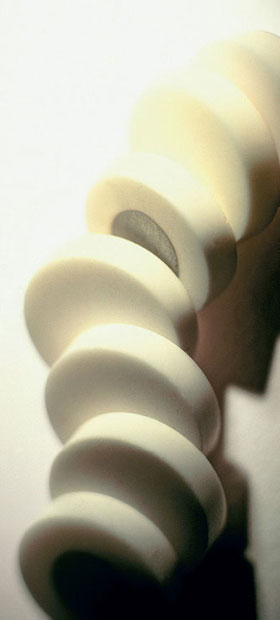
MIGUEL BOYAYANAt Ipen, ceramic tablets used in sensorsMIGUEL BOYAYAN
One French and two Brazilian researchers have developed an efficient and cheap way of producing high quality sensors through the application of electrical discharges in the ceramic material used in these products. The new technique allows the thickening of ceramic grains in the parts made as tablets, which are used in sensors to measure gases in the exhaust pipe of automobiles and for steel production in steel mills. They are also used in making temperature sensors, like those in cell phones for detecting any abnormal heating in the device, and in some types of fuel cell, equipment that produces electricity from hydrogen. Today industry makes these parts using imported equipment that costs around US$ 250,000 and that submits a compound powder to a mixture of oxides – generally, zirconium and yttrium – at pressures a thousand times greater than atmospheric pressure and at temperatures of almost 1500o Celsius for some hours. The result is rigid tablets that are largely resistant to wear and corrosion and capable of supporting high temperatures. In a partnership with French researcher, Michel Kleitz, physicists Eliana and Reginaldo Muccillo managed, though still experimentally, to create another way of obtaining the same type of product, but spending very much less money and energy.
At the end of 2010, during a two month stay in the laboratory headed up by the Muccillos in the Institute of Energy and Nuclear Research (Ipen), Kleitz saw an opportunity to test an idea that had begun to form two years previously. Instead of relying on high pressure and temperatures for producing higher density, fine grain ceramic parts (and consequently of better quality, since the properties of the ceramic are determined by the degree of the compacting of the grains) the French electro-chemist, a retired researcher from the National Polytechnic Institute of Grenoble (INPG), imagined it would be possible to force the grains together in another way. He remembered welding techniques and theoretical studies by other groups suggesting that electrical discharges could help thicken ceramic grains with dimensions in the order of nanometers (millionths of millimeter).
Decisive assembly
But the Ipen laboratory lacked a piece of equipment: a source of energy to control the passage of the electrical current through the ceramic sample. This type of apparatus is actually produced commercially, but the imported article costs US$ 18,000 and would take a long time to arrive and the one produced in Brazil would not be ready in less than 90 days. Reginaldo decided, therefore, to ask another physicist, Yamato Miyao, a retired professor from the Institute of Physics at the University of São Paulo (IF-USP), for help. Miyao designed the circuits of the source and a week later appeared in the Ipen laboratory with the equipment ready. Looking like a computer box, the apparatus enabled the initial tests to be carried out, but improvements were necessary. Two weeks later, after spending around R$ 1000 in parts in Santa Ifigênia Street, a paradise for buying electronic components in the center of São Paulo, Miyao returned with the device they needed.
Reginaldo, Kleitz and Eliana submitted 99 samples of ceramic tablets they had made in the laboratory, in the Center of Materials Science and Technology at Ipen, to a series of tests in which they either kept the temperature constant and varied the intensity of the electric current, or modified the temperature and kept the electrical current unchanged. They saw that by exposing the material for a few seconds to a high current and a temperature of between 970 and1150o Celsius it was possible to produce ceramic parts with grains as tightly packed as those obtained by the traditional, industrial process, spark plasma sintering.
There was, however, an important difference. With the new strategy, which they called flash grain welding, the compacting or sintering of the grains occurred at atmospheric pressure. Passing an alternating electrical current through the sample causes an increase in temperature in the space between the grains and starts a microscopic agitation, making the grains join together. This technique does not need expensive equipment, say the researchers in an article in which they describe the results that was accepted for publication in the Journal of the European Ceramic Society in just 22 days. “We have shown that in the 21st century it is still possible to do DIY science,” comments Kleitz.
The researchers do not know how long it will take for the new process to make high quality ceramic tablets cheaper. The technique still needs to be improved. When changing the ceramic components, however, things did not go so well. In some cases the temperature in the space between the grains became so high (it reached more than 2000 degrees) that the grains completely melted, transforming the tablet into glass. “There’s the day of the prey and the day of the hunter,” bemoaned Kleitz. We’re trying to understand what happened. Currently we’re doing one experiment a day to try and master the technique with different materials,” says Eliana. They are also studying the possibility of using the technique to produce some 200 tablets with the same properties on a pilot scale that would prove their industrial viability.
The projects
1. Study of intergranular phenomena in ceramic materials (nº 2005/53241-9); Modality Thematic Projects; Coordinator Reginaldo Muccillo – Ipen; Investment R$ 802,674.39 (FAPESP)
2. Michel Kleitz, Conseil National de la Recherche Scientifique – France (nº 2010/51293-0); Modality Support for Visiting Researcher; Coordinator Eliana dos Santos Muccillo – Ipen; Investment R$ 19,714.58 (FAPESP)
Scientific article
MUCCILLO, R. et al. Flash grain welding in yttria stabilized zirconia. Journal of the European Ceramic Society. v. 31, p. 1517-21. Jul. 2011.

